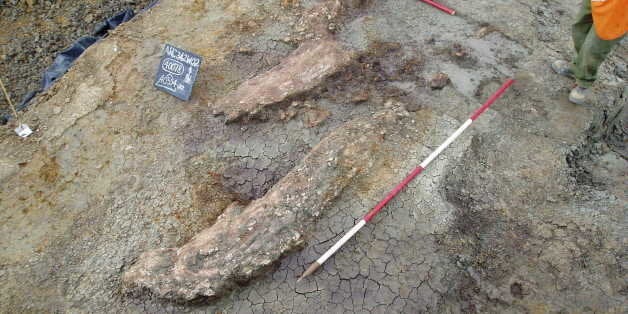
It seems even some of the earliest humans realized the power of strength in numbers.
Researchers working in southern England have spent years excavating the remains of a prehistoric elephant believed to have been butchered hundreds of thousands of years ago. And now archaeologists have released their most detailed analysis yet of the Stone Age site, shedding new light on how early humans worked together to hunt and kill large mammals for food with
The site was discovered in 2003, during the construction of a high-speed train in Ebbsfleet near Kent. Archaeologists eventually uncovered the remains of the Palaeoloxodon antiquus, a straight-tusked elephant that lived across Eurasia between 50,000 and 780,000 years ago. Flint tools found near the body are believed to have belonged to an early human species known as Homo heidelbergensis, the BBC reported.
"It is the earliest site of elephant butchery in Britain," Dr. Francis Wenban-Smith, site leader and principal research fellow at the University of Southampton, told the BBC at the time.
Wenban-Smith recently told The Huffington Post that the discovery continues to be "massively important for our understanding of what early hominins were doing, and how they were able to colonize new terrain." His post-excavation analysis provides new information about the elephant and the estimated 80 flint tools that were used to cut it into pieces some 420,000 years ago.
"Some tools for its butchery were made on the spot, but others were brought to the carcass having been made elsewhere," Wenbam-Smith said. "This suggests that early humans first exploited it for meat shortly after its death, but that they then returned to it on subsequent occasions ready-equipped, indicating forward planning."
The elephant in question was much larger than today's African elephants, according to a statement issued by the University of Southampton. If early humans did learn how to hunt and eat animals like the Palaeoloxodon antiquus, it could help explain a resurgence of the Homo heidelbergensis species in northern Europe about 400,000 years ago, the statement said.
"It's so rare to find undisturbed remains of any sort from this period," Wenbam-Smith said. "This new evidence confirms the importance of elephant in their diet. Large herbivores such as this provided vitamins and nutrients that would have been vital to survival. It may therefore have been the ability to hunt elephants and other large herbivores that allowed colonization of new territory in aftermath of ice ages."
The jawbone of a rhinoceros was also found near the elephant's bones, suggesting the area was used as a butchering site over a series of years, according to The Times of London. Researchers believe the meat was likely consumed raw, and jawbones may have been removed so that the marrow could be sucked clean, the report said.
The findings were described in Wenban-Smith's new book, The Ebbsfleet Elephant: Excavations at Southfleet Road, Swanscombe in advance of High Speed 1, 2003-4.
